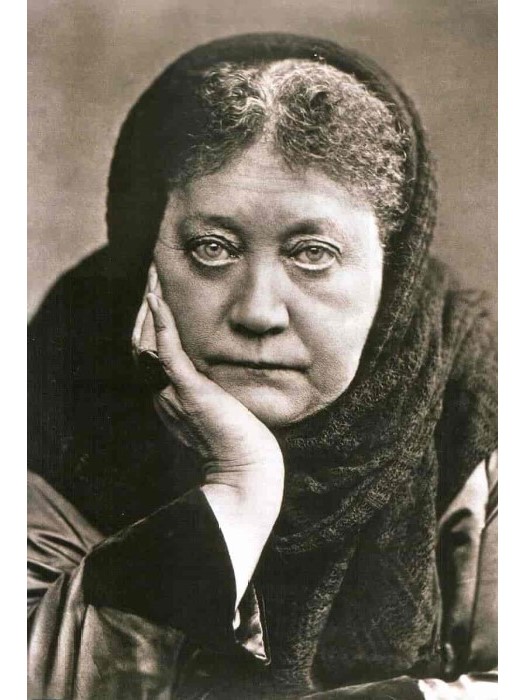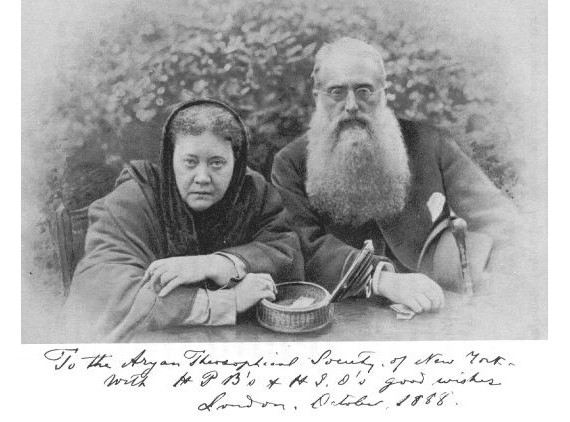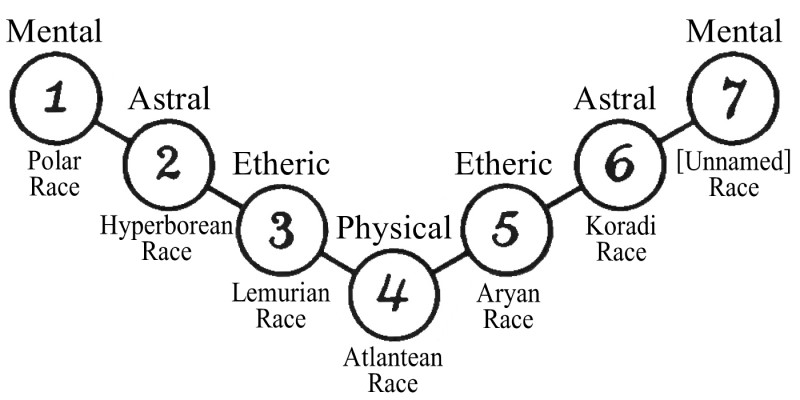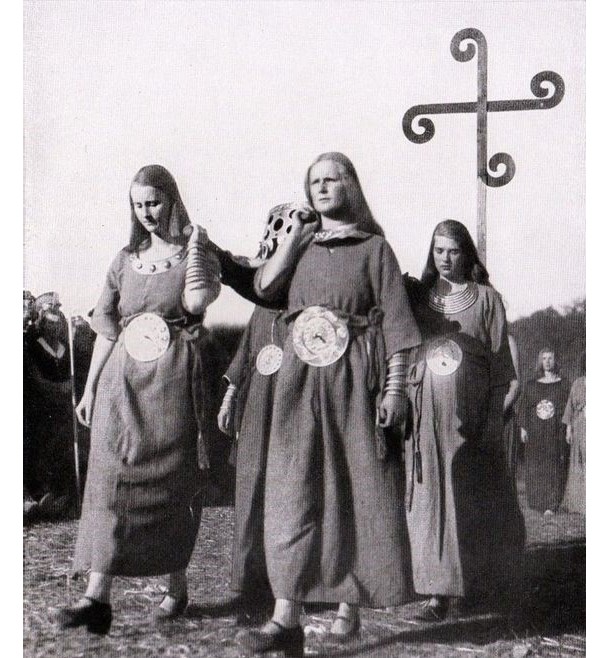Historical Context for Runology (mid to late 1800s)
In our previous class, we said that three currents from the 19th century played a role in the emergence of the Runology of the 20th century, which were:
1) the Spiritualist Movement – a combination of the ideas of Swedenborg (highlighting personal revelation) and Mesmer (emphasizing energetic healing)
2) the Od or Odic Force – Reichenbach’s idea of Vital Force(s) that emanate from all living things (somewhat similar to Mesmer’s “Living-Magnetism”)
3) the Theosophical Movement – bringing Eastern ideas to Europe (and to the West in general) and, with it, the popularity of Esotericism and Occultism
We discussed the first two in the previous class, so now let’s take look at the third: Theosophy.
3) Blavatsky’s Theosophical Movement
 Helena Petrovna Blavatsky (1831–1891) was born in Russia and studied Esotericism throughout Europe and the Middle East before eventually traveling to India and Tibet. Sometime between 1867-1868, she traveled to Constantinople, where she met Master Morya and together they traveled overland to Tibet. There they stayed with another spiritual Master named Koot Hoomi, near to Tashilhunpo Monastery, in Shigatse (modern Xigazê).
Helena Petrovna Blavatsky (1831–1891) was born in Russia and studied Esotericism throughout Europe and the Middle East before eventually traveling to India and Tibet. Sometime between 1867-1868, she traveled to Constantinople, where she met Master Morya and together they traveled overland to Tibet. There they stayed with another spiritual Master named Koot Hoomi, near to Tashilhunpo Monastery, in Shigatse (modern Xigazê).
There, Blavatsky claimed she was taught an ancient language (known as Senzar) and translated a number of ancient texts written in it that were preserved by the monks of a monastery. She also claimed that while in Tibet, she was taught how to develop and control her psychic abilities.
When she left Tibet in late 1870, she said it was with the mission of proving to the world that the phenomena identified by Spiritualists was objectively real, thereby defending it against accusations of fraud made by scientific community. However, she also stated that the entities being contacted by Spiritualist mediums were not the ‘spirits’ of the dead (as the Spiritualist movement typically alleged), but instead either mischievous elementals or the “shells” left behind by the deceased.
After traveling to Cairo in 1871, she established a société spirite with the help of Emma Cutting. This group was largely based on Spiritism (a form of Spiritualism founded by Allan Kardec which professed a belief in reincarnation, in contrast to the mainstream Spiritualist movement). However, Blavatsky believed that Cutting and many of the mediums employed by the society were fraudulent, and so she closed it down after two weeks.
 Later (after returning to Europe), in 1874, Blavatsky traveled to the United States, where she met Henry Steel Olcott, who soon became her friend and spiritual collaborator. The following year, Blavatsky, Olcott, and others (including an Irish Spiritualist named William Q. Judge) decided to establish an esoteric organization.
Later (after returning to Europe), in 1874, Blavatsky traveled to the United States, where she met Henry Steel Olcott, who soon became her friend and spiritual collaborator. The following year, Blavatsky, Olcott, and others (including an Irish Spiritualist named William Q. Judge) decided to establish an esoteric organization.
On November 17th, 1875, in New York City, the “Theosophical Society” was officially formed, which they described as “an unsectarian body of seekers after Truth, who endeavor to promote Brotherhood and strive to serve humanity”.
That same year (1875), Blavatsky began work on a book outlining her Theosophical worldview. Although she had hoped to call it “The Veil of Isis”, instead it was published as “Isis Unveiled”. While writing it, Blavatsky claimed to be aware of a second consciousness within her body, referring to it as “the lodger who is in me”, and stated that it was this second consciousness that inspired much of the writing. It was first published in two volumes in 1877.
The Theosophical Movement’s Books and Ideas
“Isis Unveiled” became very popular and all 1000 copies of the first edition sold out in one week. It has been described by Nicholas Goodrick-Clarke in his book Helena Blavatsky (2004) as teaching a universal doctrine present in all religions and cultures:
“The underlying theme among these diverse topics [in Isis Unveiled ] is the existence of an ancient wisdom-religion, an ageless occult guide to the cosmos, nature and human life. The many faiths of man are said to derive from a universal religion known to both Plato and the ancient Hindu sages.
This wisdom-religion is also identified with Hermetic philosophy as “the only possible key to the Absolute in science and theology” (vol 1, vii). Every religion is based on the same truth or “secret doctrine”, which contains “the alpha and omega of universal science” (vol 1, 511). This ancient wisdom-religion will become the religion of the future (vol 1, 613).”
By 1878, Theosophical ‘Lodges’ (formally organized groups who met regularly to study and present information to the public) were being established throughout the United States and Europe. In 1879, Blavatsky moved back to India and continued to teach her doctrine there, before returning to Europe in 1883.
 by Olcott, Henry_sm.jpg) In 1885, the Theosophical Society’s printed materials began using what is now called the ‘Theosophical Seal’ (shown on the right). This same year, Blavatsky resigned as secretary of the Theosophical Society (due to deteriorating health) and started focusing on her next book, “The Secret Doctrine”. The book was eventually published in 1888, in two volumes: the first volume is named ‘Cosmogenesis’ and the second ‘Anthropogenesis’.
In 1885, the Theosophical Society’s printed materials began using what is now called the ‘Theosophical Seal’ (shown on the right). This same year, Blavatsky resigned as secretary of the Theosophical Society (due to deteriorating health) and started focusing on her next book, “The Secret Doctrine”. The book was eventually published in 1888, in two volumes: the first volume is named ‘Cosmogenesis’ and the second ‘Anthropogenesis’.
“The Secret Doctrine” is of particular interest for our studies because this is where Blavatsky presents the concepts of the Seven Rounds and the Seven Root-Races and says that the ‘Aryan’ race is the 5th, describing it with the following words:
“The Aryan races, for instance, now varying from dark brown, almost black, red-brown-yellow, down to the whitest creamy colour, are yet all of one and the same stock – the Fifth Root-Race – and spring from one single progenitor, … who is said to have lived over 18,000,000 years ago, and also 850,000 years ago – at the time of the sinking of the last remnants of the great continent of Atlantis.”

Not only was the term ‘Aryan’ used by the Theosophical movement, but so was the swastika (visible in the upper circle of the Theosophical Seal).
-Paraphrased from Wikipedia articles
Germanic Esotericism and Spiritual Influences in the late 1800s
We have seen that Rosicrucianism and Freemasonry both had considerable influence in Germany from the early 1600s on. The ideas of a secret or special group of people (the fraternity or brotherhood) that has special spiritual knowledge and who’s goal is to help advance culture and humanity, has had over 200 years to normalize itself into European and Germanic culture.
So we have three strong influences becoming prominent in European religious or spiritual culture:
1) Great Awakenings emphasizing a need to rely on the Heart and not the Intellect;
2) the popularity of Spiritualism bringing attention to the ideas of personal revelation, the concept life after death, and the possibility of supernatural forces that can be experimented with by anyone who has proper training;
3) and, finally, a ‘magnetic’, ‘vital’ or “Odic” Force emanating from all living things which can be used to both heal and hurt.
All of them are implying that there is an unrecognized or invisible world which is readily accessible and, thus, we see a environment that is ripe for a more inclusive “special group” (formerly the fraternal organizations), adding a forth current or influence to the mix…
The ideology of this special group of people or ‘folk’ has been nourished through multiple generations in something we now call the Völkisch Movement. We may consider this to be an additional and significant influence leading to the popularity of Runic studies in the 20th century.
The Völkisch Movement
In the early 1800s (around the same time as the second Great Awakening mentioned before), the Völkisch Movement (literally ‘folk-ish’) emerged as an offshoot of Romantic nationalism.
Romantic nationalism is the idea that the country or state derives its political legitimacy “as an organic consequence of the unity of those it governs”, meaning from the people themselves. This grouping of people can be based on language, race, culture, religion, and customs of the nation, etc.
Romantic nationalism is on the opposite spectrum to the Royalist philosophy (which the Jacobites ascribed to, and related to the Rite of ‘Strict Observance’ mentioned before), which is the idea of a king or queen’s “divine right” to rule.
Scholars say that the Völkisch Movement started becoming popular through ideas like those expressed by author Johann Gottlieb Fichte in his 1808 book Reden an die deutsche Nation [Address to the german Nation ]. In this book, Fichte addresses the question of what could warrant a noble individual’s striving “and their belief in the eternity and the immortality of their work?”. This he connects with the question “What is a People (or Völk ), in the higher sense of the term, and what is love of the fatherland?”.
Fichte’s answer is that it could only be that “particular spiritual nature of the human environment out of which the person themselves, with all of their thought and action … has arisen, namely the people (or völk ) from which one is descended and among whom one has been formed and grown into that which that person is”. Here we have an idea that propels the emergence of what we now call the Völkisch Movement.
 Throughout the 1800s, the Völkisch Movement starts gradually becoming more and more popular in German speaking countries. According to historian James Webb, the word völk does not just simply translate as a people or ‘folk’, but also has “overtones of ‘nation’, ‘race’ and ‘tribe’”.
Throughout the 1800s, the Völkisch Movement starts gradually becoming more and more popular in German speaking countries. According to historian James Webb, the word völk does not just simply translate as a people or ‘folk’, but also has “overtones of ‘nation’, ‘race’ and ‘tribe’”.
There is no direct English equivalent to the term völkisch , but Webb says it might also be translated as “ethno-nationalistic”, “racial-nationalistic” or “ethno-racialist”. The defining idea, that the Völkisch Movement revolved around, was that of a Völkstum (literally “folkdom”, with a meaning similar to a combination of the terms “folklore” and “ethnicity”).
Historians emphasize the idea that the Völkisch Movement combined sentimental patriotic interest in Germanic folklore and local history with a “back-to-the-land” anti-urban philosophy. Some have claimed that its ideology was partly a “revolt against modernity” and “the longing for a self-sufficient life lived with a mystical relation to the land”.
Scholars also claim that part of the popularity of the Völkisch Movement was “a reaction to the cultural alienation of the Industrial revolution”. Like today, many people were longing for a purpose in life and the Völkisch Movement as well as Germanic/Nordic Mysticism seemed to fill that need, thus becoming more and more popular…
With the growing interest in their ‘tribe’ or ‘folk’, we naturally see an interest in the associated Mythology, folklore and, consequently, the Runes. Likewise, we see an increased curiosity regarding so-called Germanic Paganism or Pre-Christian Religious practices as another way to study similar themes and ideas.
-Paraphrased from Wikipedia articles
Fascism and the Völkisch Movement
As it evolved, the Völkisch Movement sometimes combined the esoteric aspects of folkloric occultism with “racial adoration”. During the 1900s, in some circles, we see a type of “anti-Semitism linked to exclusionary ethnic nationalism” emphasized as well. Now we start seeing different organizations using the term völk or völkisch that emphasize ideas including anti-communist, anti-immigration, anti-capitalist and anti-Parliamentarian ideas.
Although the primary interest of the Germanic Mystical Movement was the revival of native pagan traditions and customs (often set in the context of a semi-Theosophical esotericism), nonetheless a preoccupation with ‘racial’ or ‘ethnic’ purity came to motivate its more politically oriented offshoots. In the 1910s, Germanic Mystical Movement groups met in order to celebrate the summer solstice (which was also an important festivity in völkisch circles) and more regularly to read the Eddas as well as some other authors considered Germanic mystics.
As time progressed, this same word völkisch came to emphasize “ethno-nationalistic” and racial themes more and more. Scholars see völkisch ideologies as influential in the development and popularity of Nazism. In Mein Kampf [My Struggle] (1925), Adolf Hitler wrote: “the basic ideas of the National-Socialist movement are populist [völkisch ] and the populist [völkisch ] ideas are National-Socialist.”
This means that Nazi racial concepts leveraged völkisch terminology. Now the “folk” were specifically Germanic, Nordic or “Aryan” peoples, and others were seen as a threat…
-Paraphrased from Wikipedia articles
The Term “Aryan”, the “Indo-European” Language and the Völkisch Movement
Since the ‘Folk’ or Völk are a “special group”, not by personal choice (that is not by joining a Rosicrucian, Masonic or some other Fraternal organization), then how does this group define itself? Through studying their Mythology & Folklore, they are able to extract the special knowledge related to their group. However, because of the role that the Roman Catholic Church has played in suppressing “Pagan” or “Traditional” religious forms, accessing this knowledge doesn’t come easy and so, there is an attempt to discover what was destroyed or hidden.
With the study of European Pre-Christian Mythology, History, Culture and Customs (thanks to the Völkisch Movement), and the availability of Hindu and Buddhist Doctrine & Mythology in European languages (thanks to the popularity of Esotericism and, specifically, Theosophy), we see an attempt to unite the newly re-discovered information into a single system in order to restore the “original doctrine” of the Völk .
In addition to encouraging lots of speculation about the way the Völk could have lived, this is also where the Eastern term “Aryan” takes on a new meaning in the West as ‘White-European’. Let’s take a brief look at how this occurred…
According to the Encyclopaedia Britannica’s entry for the topic ‘Aryan’:
“Aryan, name originally given to a people who were said to speak an archaic Indo-European language and who were thought to have settled in prehistoric times in ancient Iran and the northern Indian subcontinent. The theory of an ‘Aryan race’ appeared in the mid-19th century and remained prevalent until the mid-20th century…
In Europe the notion of white racial superiority emerged in the 1850s, propagated most assiduously by the comte de Gobineau and later by his disciple Houston Stewart Chamberlain, who first used the term ‘Aryan’ to mean the ‘white race’. Members of that so-called race spoke Indo-European languages, were credited with all the progress that benefited humanity, and were purported to be superior to ‘Semites’, ‘yellows’, and ‘blacks’. Believers in Aryanism came to regard the Nordic and Germanic peoples as the purest members of the ‘race’.”
As an example, let’s take a look at a text from the late 1800s that discusses topics that would be of importance to those in the Völkisch Movement.
In the Introduction to Swedish author Viktor Rydberg’s Teutonic Mythology (1886, but translated into English in 1889), he tries to establish a link between European and Asian/Eastern languages as well as their religious forms.
Here the term Teutonic is used to refer to Northern European (German, Dutch, and Scandinavian, etc.):
“It is universally known that the Teutonic dialects are related to the Latin, the Greek, the Slavic, and Celtic languages, and that the kinship extends even beyond Europe to the tongues of Armenia, Irania, and India.
The holy books ascribed to Zoroaster, which to the priests of Cyrus and Darius were what the Bible is to us; Rigveda’s hymns, which to the people dwelling on the banks of the Ganges are God’s revealed word, are written in a language which points to a common origin with our own.
However unlike all these kindred tongues may have grown with the lapse of thousands of years, still they remain as a sharply-defined group of older and younger sisters as compared with all other language groups of the world. Even the Semitic languages are separated therefrom by a chasm so broad and deep that it is hardly possible to bridge it.
This language-group of ours has been named in various ways. It has been called the Indo-Germanic, the Indo-European, and the Aryan family of tongues. I have adopted the last designation. The Armenians, Iranians, and Hindoos I call the Asiatic Aryans ; all the rest I call the European Aryans.
Certain it is that these sister-languages have had a common mother, the ancient Aryan speech, and that this has had a geographical centre from which it has radiated…”
Although Rydberg is only talking about language, it is clear that this differentiation between what he calls ‘Asiatic Aryans’ and ‘European Aryans’ is an example of how the term “Aryan” is being glamorized and co-opted for the völkisch agenda.
For the Northern Europeans of the mid to late 1800s and on into the 20th century, Caucasian/White and “Aryan” start becoming essentially the same. This is how people understood things and, therefore, how they saw the world around them.
So, even with the popularity of Theosophy in the late 1800s, and with Blavatsky saying that the “Aryan Root-Race” is the 5th Root-Race and includes all the peoples across the Earth right now, this is inconsistent with how most ‘educated’ (or ‘woke’?) Europeans understand things. They already have a preconceived notion of what “Aryan” is and so they can skip over this detail and focus on what is more important to them…
In the next class, we’ll look at how the German Theosophical Movement provided an environment for Völkisch authors to share their ideas with the German-speaking public.
Download the Handout for this class:
– = Read the NEXT PART = –